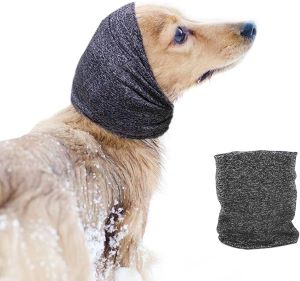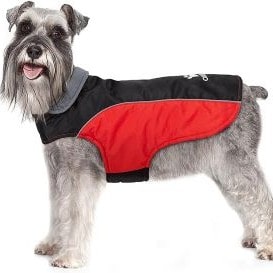With the dropping temperature in the UK, you might have wondered when could you get the chance to grab a stylish winter coat for your dog. Well, with this excitement comes the question, does your dog need a coat?
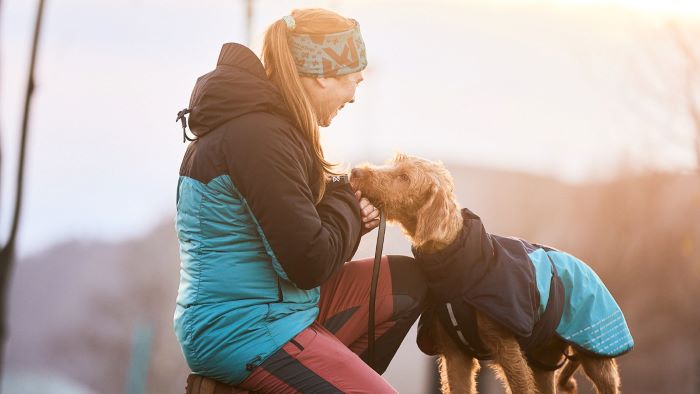
It is believed that dogs can tolerate severe colds as they have a layer of insulation. But, up to what temperatures can they protect themselves? Let’s quench your curiosity and find out at what temperature a dog needs a coat.
You Might Also Like:
Need for a Winter Coat
Whether or not your pet needs a coat depends upon the breed, size and age of your dog. Countries like the UK have relatively mild winters. Though dogs are covered with their natural insulating fur, some breeds need an extra layer of insulation.
Large dog breeds with heavy fur, for instance, Labradors, Huskies and German Shepherds do not require a winter coat even in the coldest months. However, short-coated or hairless breeds, ones with short noses and some breeds that sit low to the ground can struggle to cope with the cold weather.
Cold weather can be especially problematic for dogs who suffer from stiff joints. The low temperatures can cause muscles to tighten up and increase pressure when they are walking. In such cases, always ensure to provide warmth to your dog.
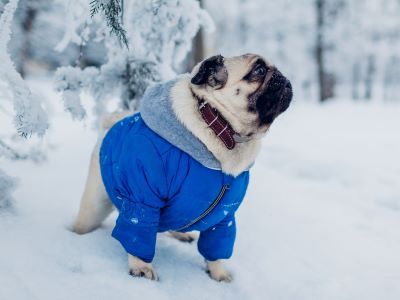
Apart from this, small puppies as well as older dogs, regardless of their breed cannot be left outside unattended. They naturally struggle to regulate their body temperature. Hence, they need a coat to keep themselves warm even for the slightest temperature drop.
Signs Your Dog Needs a Coat
Observing your dog and looking for odd behaviour is a good way to tell if your dog is getting cold or not. The very obvious sign is shivering. Just like humans, dogs too tremble and shake when exposed to severe cold.
Another way to know the need for a coat is to check your dog’s ears. You might have felt your nose cold during snowy winter days. Just like that, your dog’s ears will get cold if it’s unbearable cold for him.
Along with that, your dog might show other common symptoms like tucked tail, slow movements and whining or crying. He might also lift his paws off the ground. These are the signs that your dog is definitely catching a cold and needs a coat to be put on.

Symptoms of coldness:
- Shivering or shaking
- Cold ears
- Hesitation to go outside
- Whining or crying
- Excessive panting
- Slow walks
- Lifting paws
- Tucked tail
Remember, if your dog shows any of these symptoms it is likely that he is feeling cold. Thus, it becomes essential to protect him from the extreme conditions. Many dogs when left outside for a longer time develop hypothermia or frostbite, which could lead to adverse health effects.[1] Even dogs with thick coats can get hypothermia or frostbite in freezing weather, according to the American Kennel Club (AKC).
Thus, before taking your dog for a walk you should be conscious about your dog’s conditions. You should ensure whether your dog can withstand the cold outside or not and act accordingly. It is also important to take care of your dog after returning from outdoors. Your dog needs extra care after encountering a snowy walk.[2]
When considering a winter coat for your dog, it’s essential to ensure the perfect fit through proper measurement. How to Measure a Dog for a Coat becomes crucial in this regard. A coat that’s too tight can be uncomfortable, while one that’s too loose might not provide adequate warmth.
Temperature Specification for Your Dog
Dogs have a thick layer of fur that acts as an insulator.[3] But, not all dogs share the same quality and length of fur and so the temperature tolerance capacity of each dog breed is different and so is the need for a coat. Now, the question arises at what temperature does a dog need a coat?
There is never a particular temperature drop for which you should wait to put a winter coat on. They are the symptoms that matter. Many dog breeds can withstand the temperature of around -7°C while others feel sick even at 7°C.
At What Temperature Does Your Dog need a coat?
The temperature tolerance varies from one breed to the other as well as the period the dog spends outdoors. If a dog spends a short period in the snowy winters say, 10-15 minutes, he does not require a coat as such weather won’t affect the dog.
However, if the dog is out for a walk then he definitely requires a winter coat. When the temperature drops below zero degrees Celsius, a dog should walk out of the house with a coat on. Though they can withstand temperatures less than this, it is important to take precautions.
Small and medium-sized breeds with thinner coats will struggle at -4°C whereas larger dog breeds can withstand up to -6°C. No matter what the breed is, you should observe your dog once the temperature drops below 10°C. If he shows any specific symptoms, put on the coat no matter what temperature is it.
You should not expose your dog to harsh colds for a longer time. A short distance walk is enough to keep your pup healthy. You can also increase the frequency and decrease the time-lapse. Remember, taking your dog outdoors for a long period of time can have adverse effects on your dog.[3]
Additionally, dog rain coat with legs can also be beneficial during wet and chilly conditions. These raincoats help keep your dog dry and warm by protecting them from rain and moisture. Dogs can get uncomfortable and cold when their fur becomes wet, and this can also lead to health issues if they stay wet for prolonged periods.
Breeds That Can Tolerate the Cold
Large dog breeds with heavy fur can tolerate cold as they have a thick layer of insulation. These dogs do not require coats even at -5°C unless they have a health condition or the weather is extreme. An extra layer of insulation will overheat them.
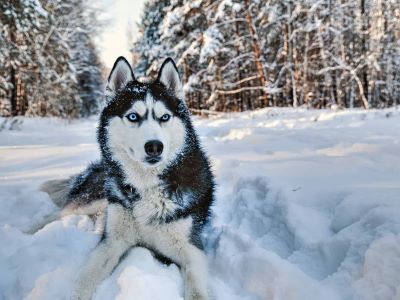
- Siberian Husky
- Alaskan Malamute
- Saint Bernard
- Newfoundland
- Japanese Akita
- Bernese Mountain Dog
- Chow Chow
- German Shepherd
- Tibetan Mastiff
- Samoyed
Even though these breeds can withstand extreme weather, it is a good idea to observe the dog and take quick action to comfort your dog when needed. Also, putting on boots can be considered while walking on snow. As mentioned in an article by petMD, “Dog boots can provide your pet’s paws with a protective layer from the snow and ice.”
Siberian Huskies and other breeds with thick coats are able to withstand frigid temperatures because their coats provide insulation, unlike humans who lose heat by sweating. This raises the question – do dogs sweat?
Breeds That Need a Coat
As mentioned, not all dogs require a coat to protect themselves in the winter. But, there are certain categories that are more vulnerable to cold weather.
Dogs with these features suffer the most from the cold:
- A slender breed, bred for warmer climates
- Small dogs with short coats
- Large dogs with short coats
- Hairless breeds
- Dogs with short noses
- Dogs that sit low to the ground
- Dogs that are clipped or shorn
- Puppies and senior dogs
- Dogs with underlying health conditions
Examples of such breeds are:
- Great Dane
- Beagle
- Poodle
- Pug
- Chihuahua
- French Bulldog
- Greyhound
- Shih Tzu
- Yorkshire Terriers
- Boxer
FAQs
Do dogs need coats in winter?
Dog breeds with short coats like Dobermans or Greyhounds can struggle to cope with extreme weather. Such breeds need a coat in winter.
What temperature is too cold for dogs to sleep outside?
Temperatures become ‘potentially life-threatening’ at anywhere below -4C for small dogs and anywhere below -9C for medium and large dogs. In these conditions, dogs can be let outside briefly to use the toilet but should not be exposed for any prolonged period.
What temperature can dogs tolerate in Celsius?
Moderately cold temperatures above 7 Celsius (45 degrees Fahrenheit) are fine for most dogs. Unless your dog is very old, sick, or hairless, he probably won’t even require an outer layer of clothing such as a sweater.
Summary
To conclude, temperature should never be your only criterion to decide whether to wrap your dog warm or not. Though certain dogs can tolerate extreme temperatures, you should always observe your dog for signs and symptoms. So, your question-‘at what temperature does a dog need a coat?’ does not emphasise the temperature.
It is good practice to better know your dog rather than looking for a thermometer drop. Always ensure your’s pet protection while going out in winter. Also, don’t force your dog to wear a coat if he does not want to, this might be a sign of overheating. At last, consult a veterinarian if there is a behavioural change in your dog during winter.
References:
- CDC. (n.d.). Prevent Hypothermia & Frostbite. Retrieved July 20, 2024, from CDC
- Shmerling, R. H., MD. (2018). 10 things you can do for your pet when it’s cold outside from Harvard Health
- Crimmins, P. (2015, July 23). The science of dog fur from WHYY
